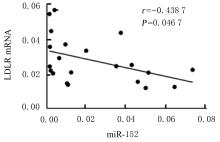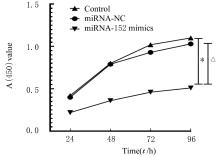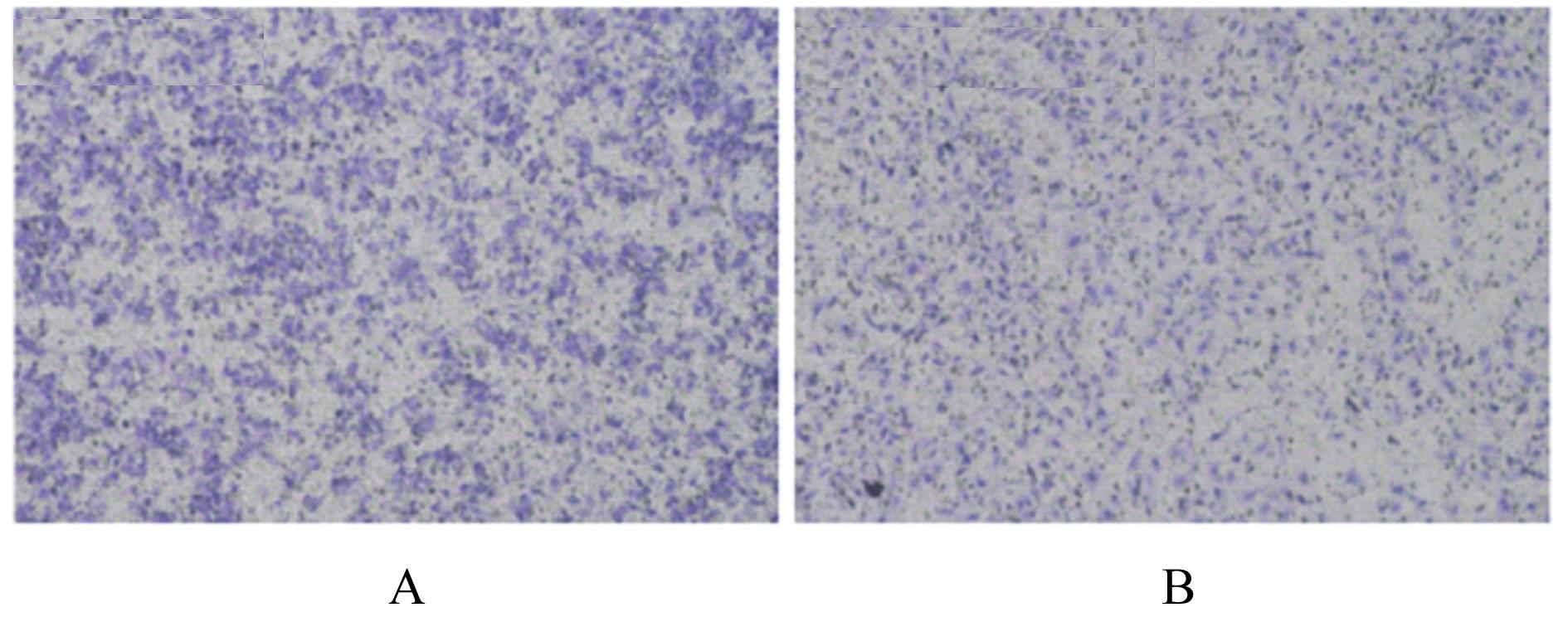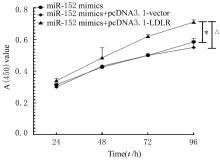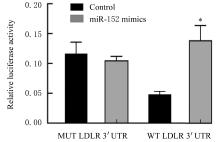Journal of Jilin University(Medicine Edition) ›› 2022, Vol. 48 ›› Issue (3): 591-599.doi: 10.13481/j.1671-587X.20220306
• Research in basic medicine • Previous Articles
Inhibitory effect of miR-152 on proliferation and invasion of endometrial carcinoma cells by reducing low-density lipoprotein receptor expression
Guowu WANG1,2,Yuan YAO1,Yu ZHANG3,Na XU1,Fang LIU2,4( )
)
- 1.Department of Obstetrics and Gynecology,First Affiliated Hospital,School of Medical Sciences,Shihezi University,Shihezi 832000,China
2.Department of Gynecology,Central Hospital,Suining City,Sichuan Province,Suining 629000,China
3.Department of Gynecology,People’s Hospital,Shihezi City,Xinjiang Uygur Autonomous Region,Shihezi 832000,China
4.Department of Gynecology,Fifth Affiliated Hospital,Southern Medical University,Guangzhou 510900,China
-
Received:2021-09-25Online:2022-05-28Published:2022-06-21 -
Contact:Fang LIU E-mail:lfdzzj@163.com
CLC Number:
- R737.33
Cite this article
Guowu WANG,Yuan YAO,Yu ZHANG,Na XU,Fang LIU. Inhibitory effect of miR-152 on proliferation and invasion of endometrial carcinoma cells by reducing low-density lipoprotein receptor expression[J].Journal of Jilin University(Medicine Edition), 2022, 48(3): 591-599.
share this article
Tab. 1
General data and biochemical indexes of patients in two groups"
| Group | n | Age (years) | BMI (kg·m-2) | BM (m/kg) | WC (l/cm) | SBP (P/mmHg) |
|---|---|---|---|---|---|---|
| Normal | 39 | 59.21±5.41 | 22.68±2.41 | 59.10±6.81 | 90.15±8.18 | 123.70±14.15 |
| Tumor | 21 | 60.62±7.32 | 26.73±3.51 | 64.48±8.44 | 97.00±9.51 | 125.30±16.78 |
| P | 0.785 0 | 0.000 2 | 0.048 6 | 0.003 5 | 0.865 9 | |
| Group | n | TC [cB/(mmol·L-1] | TG [cB/(mmol·L-1] | HDL [cB/(mmol·L-1] | LDL [cB/(mmol·L-1] | DBP (P/mmHg) |
| Normal | 39 | 3.65±0.75 | 1.35±0.51 | 1.23±0.80 | 2.13±0.73 | 70.59±9.58 |
| Tumor | 21 | 4.17±0.94 | 1.54±0.40 | 1.11±0.59 | 3.15±0.93 | 70.52±8.48 |
| P | 0.046 4 | 0.004 4 | 0.329 3 | 0.002 2 | 0.815 1 |
Tab. 3
Score of target gene LDLR predicted by miRDB database"
| Target detail | Target rank | Target score | miRNA name | Gene symbol | Gene description |
|---|---|---|---|---|---|
| Details | 1 | 100 | has-miR-152-3P | SOS2 | SOS Ras/Rho guanine nucleotide exchange factor 2 |
| Details | 2 | 100 | has-miR-152-3P | CDK19 | Cyclin dependent kinase 19 |
| Details | 3 | 99 | has-miR-152-3P | UBE2D3 | Ubiquitin conjugating enzyme E2 D3 |
| Details | 4 | 99 | has-miR-152-3P | RPS6KA5 | Ribosomal protein S6 kinase A5 |
| Details | 5 | 99 | has-miR-152-3P | HOMER1 | Homer scaffold protein 1 |
| Details | 6 | 99 | has-miR-152-3P | BCL2L11 | BCL2 like 11 |
| Details | 7 | 99 | has-miR-152-3P | LDLR | Low density lipoprotein receptor |
| Details | 8 | 99 | has-miR-152-3P | CBLB | Cbl proto-oncogene B |
| Details | 9 | 99 | has-miR-152-3P | MEOX2 | Mesenchyme homeobox 2 |
| Details | 10 | 99 | has-miR-152-3P | KMT2A | Lysine wethyltransferase 2A |
| Details | 11 | 99 | has-miR-152-3P | WDR47 | WD repeat domain 47 |
| Details | 12 | 99 | has-miR-152-3P | NPTN | Neuroplastin |
| 1 | CROSBIE E J, KITSON S J, MCALPINE J N, et al. Endometrial cancer[J]. Lancet, 2022, 399(10333): 1412-1428. |
| 2 | 周 琦, 吴小华, 刘继红, 等. 子宫内膜癌诊断与治疗指南(第四版)[J]. 中国实用妇科与产科杂志, 2018, 34(8): 880-886. |
| 3 | WANG H G, YANG Q J, LI J P, et al. microRNA-15a-5p inhibits endometrial carcinoma proliferation, invasion and migration via downregulation of VEGFA and inhibition of the Wnt/β-catenin signaling pathway[J]. Oncol Lett, 2021, 21(4): 310. |
| 4 | GENG A Z, LUO L, REN F Y, et al. miR-29a-3p inhibits endometrial cancer cell proliferation, migration and invasion by targeting VEGFA/CD C42/PAK1[J]. BMC Cancer, 2021, 21(1): 843. |
| 5 | SUN X M, HOU L T, QIU C P, et al. miR-501 promotes tumor proliferation and metastasis by targeting HOXD10 in endometrial cancer[J]. Cell Mol Biol Lett, 2021, 26(1): 20. |
| 6 | CORREIA DE SOUSA M, GJORGJIEVA M, DOLICKA D, et al. Deciphering miRNAs’ action through miRNA editing[J].Int J Mol Sci,2019,20(24): E6249. |
| 7 | GE S K, WANG D, KONG Q L, et al. Function of miR-152 as a tumor suppressor in human breast cancer by targeting PIK3CA[J]. Oncol Res, 2017, 25(8): 1363-1371. |
| 8 | LIU P H, WU L X, CHAND H, et al. Silencing of miR-152 contributes to DNMT1-mediated CpG methylation of the PTEN promoter in bladder cancer[J]. Life Sci, 2020, 261: 118311. |
| 9 | LI B, XIE Z S, LI B. miR-152 functions as a tumor suppressor in colorectal cancer by targeting PIK3R3[J]. Tumour Biol, 2016, 37(8): 10075-10084. |
| 10 | 黄雨欣,雷 蕾,华克勤,辛卫娟.长链非编码RNA R P11-395G23.3在子宫内膜癌中的表达及其临床意义[J].同济大学学报(医学版),2021,42(3):321-326. |
| 11 | ZHAO YOU-BO, YUAN D Z, PAN J L, et al. Effect of progesterone-induced microRNA-152 on the proliferation of endometrial epithelial cells[J]. J Sichuan Univ Med Sci Ed, 2016, 47(2): 147-151. |
| 12 | BJORNSSON E, GUNNARSDOTTIR K, HALLDORSSON G H, et al. Lifelong reduction in LDL (low-density lipoprotein) cholesterol due to a gain-of-function mutation in LDLR[J]. Circ Genom Precis Med, 2021, 14(1): e003029. |
| 13 | FELDT M, MENARD J, ROSENDAHL A H, et al. The effect of statin treatment on intratumoral cholesterol levels and LDL receptor expression:a window-of-opportunity breast cancer trial[J]. Cancer Metab, 2020, 8(1): 25. |
| 14 | NIU X L, NONG S R, GONG J Y, et al. miR-194 promotes hepatocellular carcinoma through negative regulation of CADM1[J]. Int J Clin Exp Pathol, 2020, 13(7): 1518-1528. |
| 15 | LI X N, YANG H, YANG T. miR-122 inhibits hepatocarcinoma cell progression by targeting LMNB2 [J]. Oncol Res, 2020, 28(1): 41-49. |
| 16 | SARVIZADEH M, MALEKSHAHI Z V, RAZI E, et al. microRNA: a new player in response to therapy for colorectal cancer[J]. J Cell Physiol, 2019, 234(6): 8533-8540. |
| 17 | HUANG S L, TAN X H, HUANG Z C, et al. microRNA biomarkers in colorectal cancer liver metastasis[J]. J Cancer, 2018, 9(21): 3867-3873. |
| 18 | LI L W, XIAO H Q, MA R, et al. miR-152 is involved in the proliferation and metastasis of ovarian cancer through repression of ERBB3 [J]. Int J Mol Med, 2018, 41(3): 1529-1535. |
| 19 | XIANG Y, MA N, WANG D, et al. miR-152 and miR-185 co-contribute to ovarian cancer cells cisplatin sensitivity by targeting DNMT1 directly: a novel epigenetic therapy independent of decitabine[J]. Oncogene, 2014, 33(3): 378-386. |
| 20 | ZHANG H Y, LU Y X, WANG S R, et al. microRNA-152 acts as a tumor suppressor microRNA by inhibiting krüppel-like factor 5 in human cervical cancer[J]. Oncol Res, 2019, 27(3): 335-340. |
| 21 | HUANG S D, LI X H, ZHU H T. microRNA-152 targets phosphatase and tensin homolog to inhibit apoptosis and promote cell migration of nasopharyngeal carcinoma cells[J]. Med Sci Monit,2016,22:4330-4337. |
| 22 | JEON H, BLACKLOW S C. Structure and physiologic function of the low-density lipoprotein receptor[J]. Annu Rev Biochem, 2005, 74: 535-562. |
| 23 | WILLNOW T E, NYKJAER A, HERZ J. Lipoprotein receptors: new roles for ancient proteins[J]. Nat Cell Biol, 1999, 1(6): E157-E162. |
| 24 | STOPSACK K H, GERKE T A, ANDRÉN O, et al. Cholesterol uptake and regulation in high-grade and lethal prostate cancers[J].Carcinogenesis,2017,38(8):806-811. |
| 25 | SUN Y, FENG Y, ZHANG G Q, et al. The endonuclease APE1 processes miR-92b formation, thereby regulating expression of the tumor suppressor LDLR in cervical cancer cells[J]. Ther Adv Med Oncol, 2019, 11: 1758835919855859. |
| 26 | CHEN Z Y, CHEN L, SUN B, et al. LDLR inhibition promotes hepatocellular carcinoma proliferation and metastasis by elevating intracellular cholesterol synthesis through the MEK/ERK signaling pathway[J]. Mol Metab, 2021, 51: 101230. |
| [1] | Yifan ZHANG,Jie DING,Min DU,Xiaoteng FENG,Ping LIU. Effects of salvianolic acid B on atherosclerosis and efferocytosis of macrophages of mice and their mechanisms [J]. Journal of Jilin University(Medicine Edition), 2022, 48(3): 561-567. |
| [2] | Xiaoyan LI,Wei ZHANG,Jie HE. Promotion effect of REG1A on proliferation and migration of lung adenocarcinoma cells by regulating Wnt/β-catenin signaling pathway [J]. Journal of Jilin University(Medicine Edition), 2022, 48(2): 444-453. |
| [3] | Guangsong XU,Haibing JIANG,Jing PAN,Guoqing LI. Inhibitory effects of betulinic acid on migration and invasion of gastric cancer MGC-803 cells and their mechanisms [J]. Journal of Jilin University(Medicine Edition), 2022, 48(1): 122-128. |
| [4] | Chaofeng ZHOU,Shifan ZHOU,Qing TIAN,Sai WANG,Honglin LI,Chunzheng MA. Effect of lncRNA-NORAD overexpression on biological behaviors of esophageal cancer Eca-109 cells and its mechanism [J]. Journal of Jilin University(Medicine Edition), 2022, 48(1): 33-43. |
| [5] | Naigao TANG,Genjian ZHENG. Effects of miR-762 on proliferation and apoptosis of human tongue squamous cell carcinoma cells by targeting NCOR1 expression [J]. Journal of Jilin University(Medicine Edition), 2021, 47(5): 1099-1107. |
| [6] | Yajie CAO,Xiaohong BAO,Shuzhen LI,Haiying GENG,Zengxiaorui CAI,Chunmei DAI,Ning LI. Effects of insulin-like growth factor 1 receptor inhibitor NVP-AEW541 on proliferation, migration and invasion of ESCC cells [J]. Journal of Jilin University(Medicine Edition), 2021, 47(5): 1131-1138. |
| [7] | Lisong CHEN,Hui FANG,Hefei WANG,Chengyuan HE,Xiaodong GAI,Chun LI. Effects of Notch1 signaling pathway on invasion and cisplatin resistance of lung adenocarcinoma cells and their mechanisms [J]. Journal of Jilin University(Medicine Edition), 2021, 47(5): 1171-1177. |
| [8] | Chen WANG,Jun TIAN,Hailing CHENG. Effect of human umbilical cord mesenchymal stem cells on proliferation and apoptosis of cervical cancer HeLa cells and its mechanism [J]. Journal of Jilin University(Medicine Edition), 2021, 47(5): 1187-1193. |
| [9] | Meng QU,Shiya WENG,Hong ZHENG,Yan LI,Runze GAO,Shenggao WANG,Chunyan YU,Boxue CHEN,Zhiheng DONG. Protective effect of fermented red ginseng total saponins on rat myocardial interstitial fibroblasts cultured with high glucose and its mechanism [J]. Journal of Jilin University(Medicine Edition), 2021, 47(5): 1201-1208. |
| [10] | Aiping WEN,Le LUO,Zhiwei MENG,Jingji JIN,Honggui ZHOU,Jihong ZHU. Expression of Tip60 protein in endometrial adenocarcinoma tissue and its clinical significance [J]. Journal of Jilin University(Medicine Edition), 2021, 47(5): 1244-1249. |
| [11] | Siyu LI,Min ZHAO,Maoling YANG,Nong XIAO,Wei JIANG. Regulatory effect of retinoic acid on proliferation of hippocampal neural stem cells after hypoxic-ischemic brain damage in rats via GSK-3β [J]. Journal of Jilin University(Medicine Edition), 2021, 47(5): 1077-1085. |
| [12] | Lijing QIN,Bing HAN,Zhongqi LI,Qi SUO,Zhen JIA,Hongli CUI,Weiqiang XU,Fang FANG,Zhicheng WANG. Effects of targeting-silenced ATRX on cell cycle arrest and apoptosis induced by radiation in cervical cancer HeLa cells [J]. Journal of Jilin University(Medicine Edition), 2021, 47(4): 904-910. |
| [13] | Dongli ZHANG,Ruifang FU,Guixia SUN. Effect of oxymatrine on proliferation and apoptosis of cervical cancer SiHa cells and its mechanism [J]. Journal of Jilin University(Medicine Edition), 2021, 47(4): 951-957. |
| [14] | Zhenhui MA,shulian LYU,Yaping TIAN. Effects of Bozhi glycopeptide on proliferation and adhesion function of human keratinocytes and its mechanism in treatment of psoriasis [J]. Journal of Jilin University(Medicine Edition), 2021, 47(4): 965-970. |
| [15] | Juan CAO,Weibo LI,Xiu GUO,Bo LI,Chunling DONG. Effects of targeted silencing of heat shock protein 27 on invasion and migration of oral squamous cell carcinoma CAL27 cells and their mechanisms [J]. Journal of Jilin University(Medicine Edition), 2021, 47(4): 971-977. |
|
||






